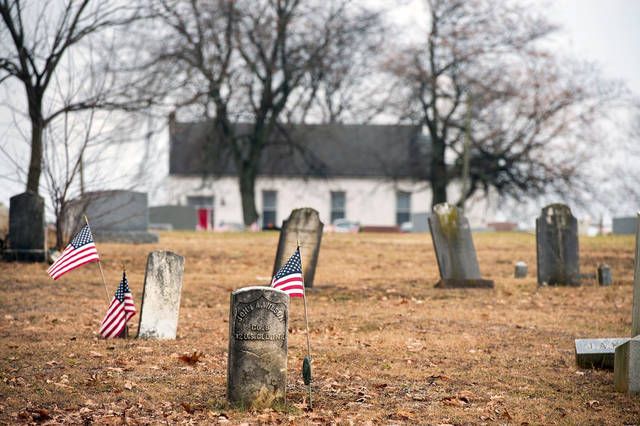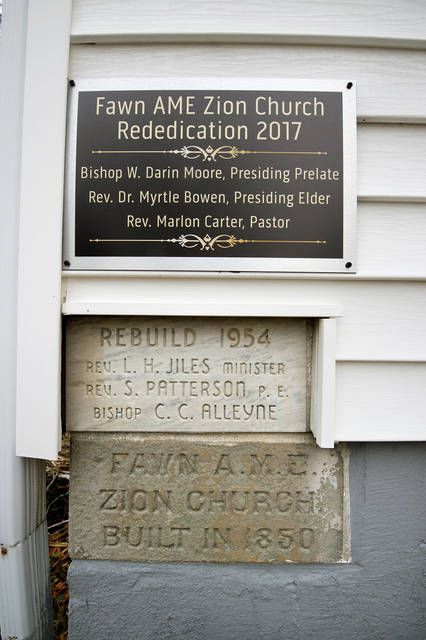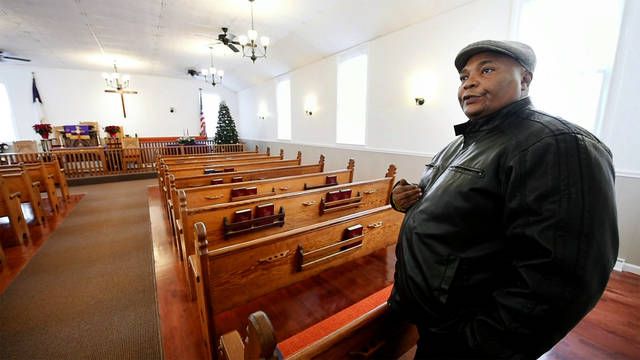Click here to subscribe today or Login.
NEW PARK — Pastor Marlon Carter walked through the cemetery at Fawn AME Zion Church, gazing at the markers. He got chills, and it wasn’t from the cold wind coming off the corn field next door.
“The history,” he said. “It’s all around you.”
And it is. The small church cemetery has markers dating to the middle of the 19th century. One man named Tillman, according to his tombstone, lived to be 94, an extraordinary feat in the 1800s. It wasn’t easy living back then, Carter said. It was hard work. There are stones marking the graves of the 18 Civil War veterans who belonged to the church. There are markers of the founding members, dating to the late 1800s.
The church itself is a small white structure, with the requisite red door, atop a hill on Alum Rock Road in New Park, not far from the Mason-Dixon Line. It looks like a country church from a Norman Rockwell painting.
Carter looked at the building and said, “I love this church. I’m honored to be a part of this church.”
The history is a large reason for that. And a large reason that Carter felt chills as he walked through the cemetery on a cold, overcast morning.
Church beginnings
In the early 1800s, a number of African-Americans from the Aberdeen area in Maryland migrated north, leaving the slave state of Maryland for freedom in the Commonwealth of Pennsylvania. Some of them were free; even though Maryland was a slave state, many plantation owners freed their slaves long before the state outlawed slavery after the Civil War.
Many of the African-Americans settled in southern York County, working as tenant farmers or sharecroppers for the owners of the large farms in the area. It was a way of life, and work, that they knew, many coming from the tobacco, tomato and bean fields of Maryland’s Eastern Shore.
It was a hard life — and hard work. The one thing that helped them get through tough times was their faith.
They had no church of their own and attended services at St. John’s, a white Methodist church in Fawn Grove. They were not permitted to sit in the pews and were segregated to the balcony seats in the rafters. When communion was given, they were permitted to participate, but if the preacher ran out of hosts, they were out of luck.
They held services independently, gathering in their log cabins on the farms where they toiled. Among those was the farm owned by a man named James Wiley. Wiley didn’t think his church was treating its African-American parishioners in a Christian-like manner. But back then, there wasn’t a lot he could do about it within the church. Churches weren’t ready to integrate, and attitudes about race hadn’t even begun to evolve.
The families that gathered to worship talked about starting their own church. They were interested in establishing a congregation of the African Methodist Episcopal Zion Church, first established in 1794 in New York. The church had a history of fighting for social justice, counting among its members Frederick Douglass and Harriet Tubman. The church became known as the Freedom Church for its early gestation of the abolition movement. It is often thought of as the precursor to the NAACP. “All week long, you could be a slave, but on Sunday morning, you were free,” Carter said.
The group appointed three men as trustees — Edward Harris, Abraham Barton and George Boyd. They met with Wiley and told him about their desire to establish their own church.
Wiley was fairly progressive, and as a Christian, he felt obliged to help the men and women he considered neighbors and brothers and sisters in Christ worship as they saw fit.
He gave a group of them a parcel of land, deeding it to them on Sept. 4, 1849, for the cost of recording the transaction.
Church development
Wiley worked alongside his African-American neighbors, clearing the land and cutting the timber into boards to build the church. The small structure was completed in 1850, and the church joined the AME denomination.
The church had a preacher assigned to it from Baltimore, and on Sundays, parishioners would travel by horse and buggy to pick him up in Muddy Creek Forks.
When the Civil War broke out, according to church member Steve Doweary, who has compiled a history of the church, many of the young men in the congregation enlisted in the Union Army. One of them, John Wilson, was among the African-American militiamen who burned down the Wrightsville-Columbia bridge to prevent the Confederates from crossing the Susquehanna. Eighteen Civil War veterans are buried in the church cemetery.
The church grew over the decades. By the 1940s, the old church was showing some wear and the congregation had outgrown it. The church asked the AME Zion church for money to build a new church, but was denied. The congregation took on the job of building the church themselves. They were a talented group, having worked in farming and some having their own construction businesses.
The new church was completed in 1954.
The church was the community’s heart. During the summers, families gathered for special day-long celebrations called camp meetings. They would gather for services and have a picnic. The men and boys would play baseball or softball or horseshoes in the field next to the church. They would have pheasant or groundhog hunts. They always ended the day with a memorial service in the cemetery, in the words of Doweary, “to show appreciation to their loved ones who had passed to the great beyond.”
Coming together in crisis
This history was almost lost when the church closed down in 2013 after a pipe burst and flooded the basement.
The congregation stayed together and worshipped at Small Memorial AME Zion in York. And they set about rebuilding the church.
The water damage was extensive, and black mold had spread from the basement into the walls of the sanctuary. It was a mess, Doweary said. And it was a big job.
The congregation did nearly all of the work itself, calling in contractors to do plumbing and other tasks.
A year ago, Pastor Carter was assigned to the church. Carter, a Navy veteran who survived the bombing of the USS Cole in October 2000, rallied the congregation around the motto, “Let’s build something together.”
The church was rededicated in October. More than 200 people packed into the sanctuary for the service. “It was standing room only,” Carter said.
Many of the families who trace their roots to the founding of the church still attend services there, even though many no longer live in southern York County and have to drive half an hour or more to get to church. They are committed to their church, and to the history, the history of their families, that it represents. And they are committed to bringing back some of the church’s traditions — its strawberry festival, its pancake breakfasts and its fish fries.
Tonya Harris-Moskoff represents the eighth generation of her family in the church. She makes the hour-and-15-minute drive from her home in Manheim to church every Sunday. Her grandfather, Roy “Bud” Harris, was instrumental in saving the church when it went through rough times at the turn of the century. Her great-great-great-great-grandfather was Edward Harris, one of the church’s founders. Her grandchildren will be baptized in the church, the 10th generation to do so. She and her grandmother, Geraldine, laid out the new floor plan for the renovated kitchen in the church’s basement, knowing that they would be doing a lot of cooking there. Her family history is written on the markers in the church cemetery.
“This church is my family’s legacy,” said Harris-Moskoff, 47, who is an executive chef and restaurant manager. “Some people have a famous name — like the Kardashians or the Kennedys — but for our family, our legacy is a little piece of property in the country with the little white church. It truly is who I am and how I was created.”
Carter is awed by the deep connection his parishioners have to the church, and he hopes to honor it.
“We want to keep this rich history and this rich legacy moving forward,” Carter said. “For those who built this for us, we have to uphold that legacy. It’s a part of who we are.”







